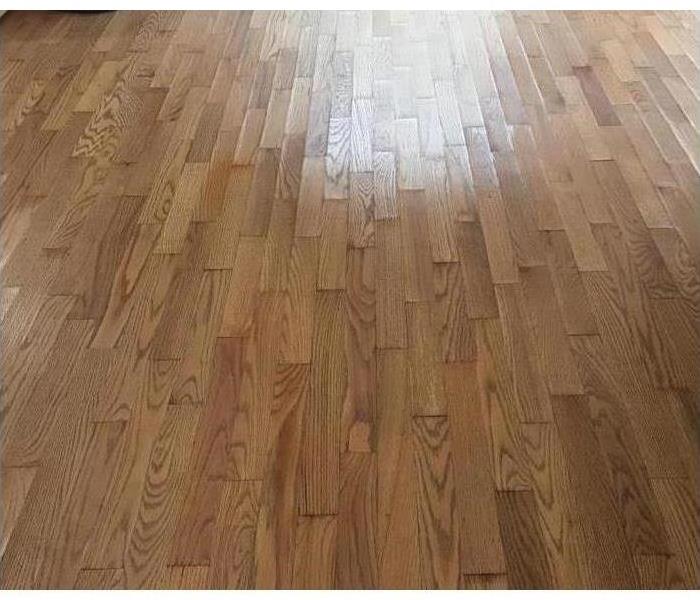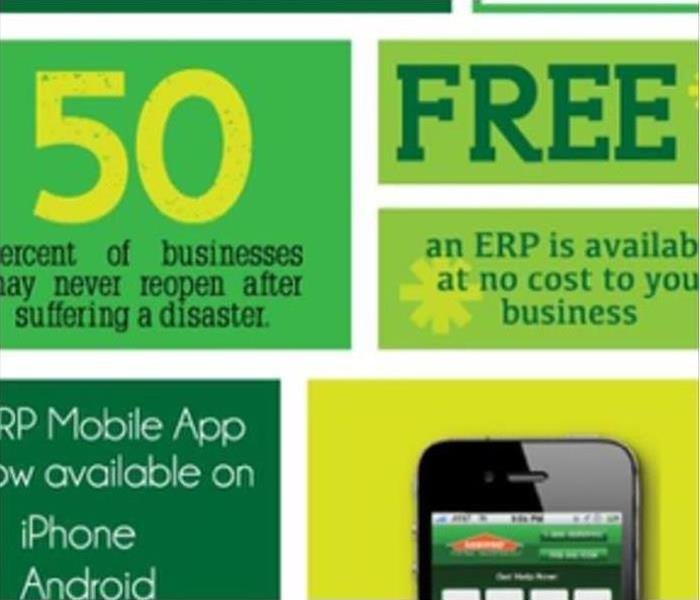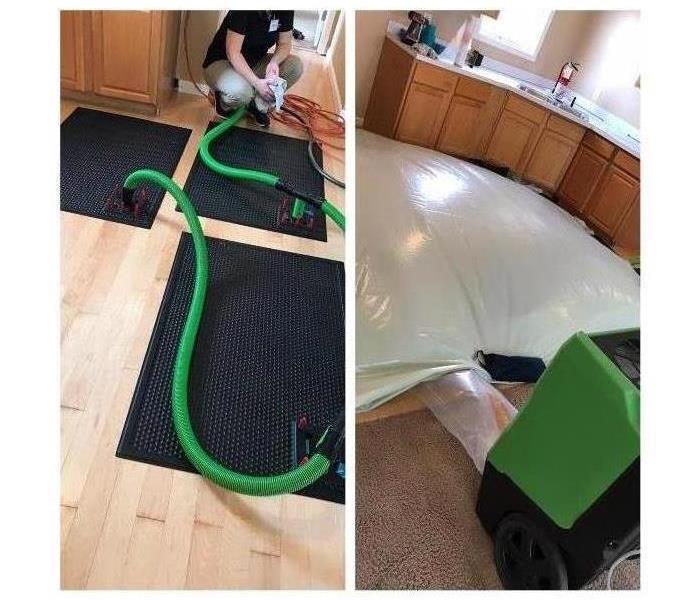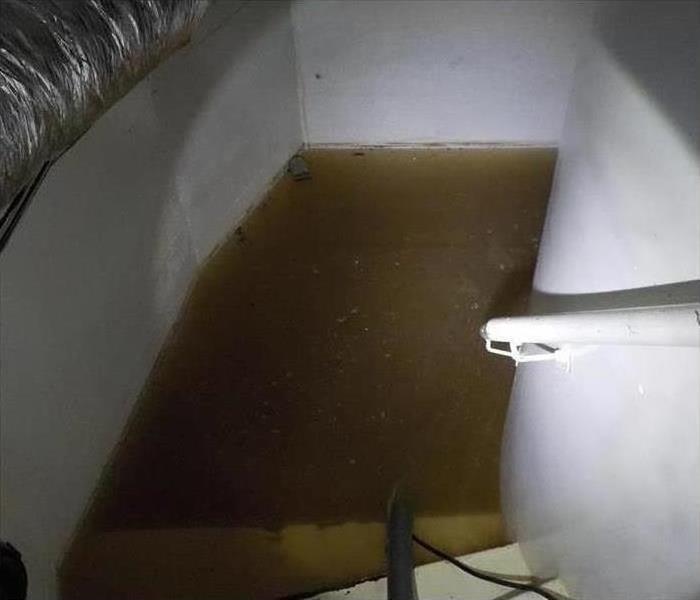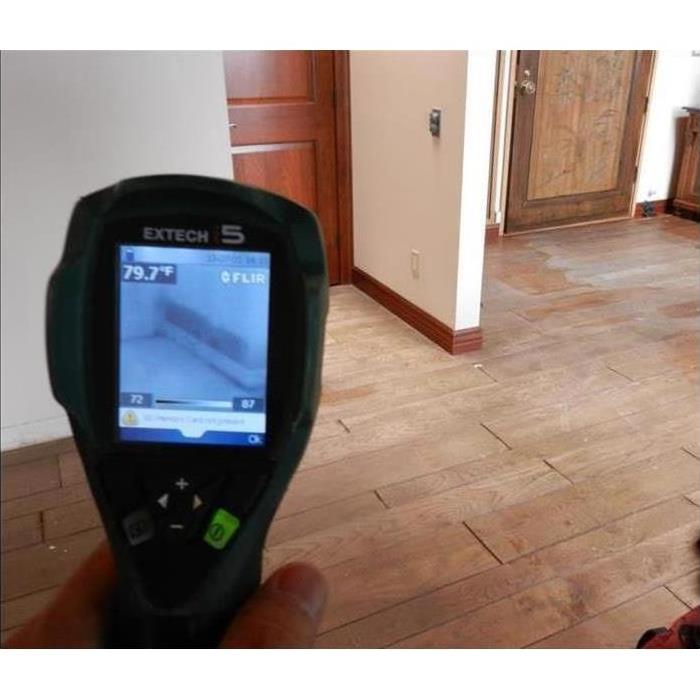Archived Water Damage Blog Posts
Signs of Hidden Water Damage in Walls
4/9/2025 (Permalink)
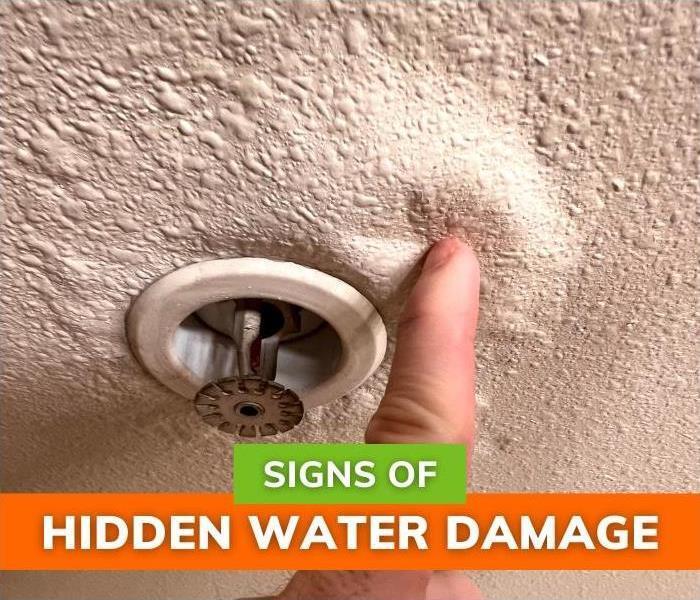 Water damage in the wall
Water damage in the wall
Signs of Hidden Water Damage in Walls
Sometimes, water damage leaves obvious signs, such as leaky pipes or water puddles on the floor. However, leaks can also start behind your walls and slowly deteriorate your pipes, building materials, and insulation. When you find the leak, you already have ruined drywall or significant mold contamination.
Knowing the signs of hidden water damage in walls can help you catch leaks early on. If you suspect water damage, HVAC professionals can inspect your pipes, walls, floors, and ceiling to find the source and repair the issue. They can also assist you during post-fire property recovery.
What Causes Hidden Water Damage?
Once you detect signs of hidden water damage in walls, you'll need to find the source to prevent further damage. Common causes of water damage include:
- Floodwaters
- Excessive condensation
- Clogged or leaking pipes
- Gaps in your roof
- Foundation cracks
- Broken appliances
- Inadequate window seals
Clean water doesn't contain pollutants, making it safer to handle. Some appliances produce grey water, which contains food particles. Black water is sewage that may contaminate your house with bacteria, parasites, and feces. This kind of water damage requires you to sanitize the space.
What Are the Signs of Water Damage?
Soft Drywall
When water seeps into drywall, the material eventually softens and crumbles, leaving you with stained, sagging drywall that detracts from your home's appearance. If you have wallpaper, look out for peeling or discoloration. Wet drywall is often a breeding ground for mold and mildew. Worse, the drywall could eventually collapse and threaten your home's integrity.
Typically, professionals remove the damaged drywall before the moisture spreads any further. They might cut out the damaged section and dry the area, then replace any building materials that experienced water damage. If mold is a concern, they could sanitize your wall. Finally, they'll add new drywall and paint the area to make it look seamless.
Peeling Paint
As water trickles down your wall, the paint might feel soft and moist. Bubbling, flaking, and chipping are common. If you try to repaint your wall, the paint will flake off again, so contact water restoration experts. They'll clean and dry your wall so that you can remove the discolored paint and apply a fresh coat.
Trickling Water Sounds
Mysterious trickling sounds indicate that you have a leak that you can't see. The leak causes damage inside your walls that you might not notice until drywall collapses or your paint starts deteriorating. If you hear trickling noises, call for help as soon as possible.
Mold Growth
Mold and mildew growth are two of the biggest signs of hidden water damage to walls. When you enter a contaminated room, you may notice musty odors, sagging ceilings, and black splotches or discoloration on the walls. Mold exposure causes flu-like symptoms, such as coughing, sneezing, red eyes, and headaches. People with asthma could suffer from frequent attacks.
You can remove small mold patches yourself. However, if you have significant mold growth inside your walls, consider hiring professionals to open your walls, remove the spores, seal the leak, and dry the area. Additionally, if spores enter the ductwork, you might need to clean your entire house. Your HVAC system could circulate spores throughout your house, leading to further contamination.
High Water Bills
If your water bills keep rising and you haven't used more water than usual, you probably have a leak. During water damage restoration, professionals use tools to locate the source and shut off the leak. Afterward, they'll determine if you have clean water, grey water, or black water, then survey the damage and move furniture out of the way.
Excessive Humidity
While some condensation on your window is normal, excessive moisture may indicate a leak inside your walls. Check the seals around your doors and windows to see if they let moisture inside your house.
Wet Insulation
Wet insulation is typically less effective, creating cold patches in your house. Mold and mildew can also grow inside the insulation. If you have a small patch of wet insulation, you can dry it out. Otherwise, hire experts to replace your insulation before it contaminates your space with bacteria.
Low Water Pressure
Low water pressure may indicate that your pipes have sprung a leak. As water spills out of the gap, your faucet produces a trickle instead of a full blast. Leaks are particularly common in older houses with outdated and corroded pipes.
Efflorescence
Efflorescence is a white, chalky substance that you find on wood, brick or concrete walls. This substance indicates that you have water leaking and drying on your walls, leaving salts and minerals behind. Over time, the water gradually seeps into your walls and weakens the structure until they're in danger of collapsing.
You can clean efflorescence off the surface, but you'll need to repair the leak to keep it from happening again. Some homeowners cover their walls with waterproofing chemicals to prevent excess moisture.
Invest in Commercial Air Duct Cleaning
If you detect musty smells, mold mildew growth, or poor indoor air quality (IAQ) in your house, contact SERVPRO® of Arcadia to learn more about commercial air duct cleaning. We'll use professional equipment to clean your ducts, improving their efficiency and boosting your IAQ. This service also extends your ductwork's lifespan.
10 Effective Ways to Prevent Water Damage During the Rainy Season
2/27/2025 (Permalink)
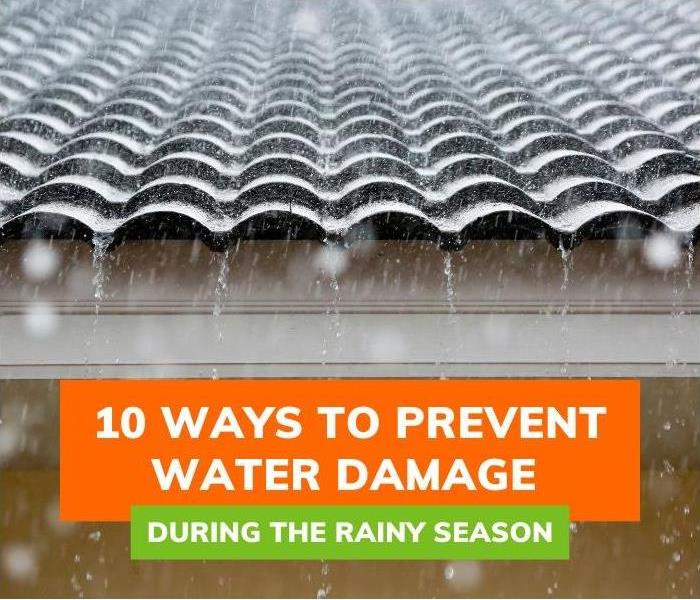 Rain falling on a rooftop
Rain falling on a rooftop
10 Effective Ways to Prevent Water Damage During the Rainy Season
Even a small leak could cause serious water damage when the rainy season arrives. Water gradually trickles inside, soaking your floors, walls, or furniture and encouraging bacterial growth. You may notice sagging ceilings, wet patches on the floor, black splotches on the wall,l and mysterious respiratory issues.
Once you learn how to prevent water damage during the rainy season, you'll reduce your risk of leaks, keeping your property clean and dry. Many of these tasks protect your home throughout the year, so make them part of your maintenance routine.
1. Inspect Your Roof
A roof inspection once or twice a year could protect your home from leaks and storm damage. Inspectors check your roof for cracked shingles, damaged gutters, unsealed vents, and other issues. They'll also check your attic for weak spots, such as poor insulation, rotting wood, pest infestations, and mildew growth. Afterward, your inspector gives you a report and makes recommendations.
If your roof needs maintenance, they may give you a price estimate. Taking care of small issues now could prevent costly repairs and protect your house from water leaks. Consider replacing your roof once it's 20 years old for older houses.
2. Check Your Foundation
Over time, your foundation can shift, developing cracks and holes that allow water to seep into your basement and crawlspace. Storm damage could worsen the cracks. Hire an inspector to check your foundation, then make repairs as necessary. Professionals can also waterproof your basement to reduce the risk of floods and protect your belongings.
3. Buy a Sump Pump
If you already have a sump pump, invest in one. Sump pumps reside in a basin on your basement floor. When the sensor detects rising waters, the device pumps water out of your house and sends it through the discharge line, which empties the water outside. This prevents floods that could ruin your basement.
Test the device by pouring water into the basin if you have a sump pump. The sump pump should drain the water away from your property. Sump pumps can go bad after long periods of non-use, so call a professional if the water isn't draining. You might need to order a replacement.
4. Use Sandbags
If you live in a high-risk area for floods, sandbags create a wall around your house that blocks the flow. Some water might seep through, but sand is a durable material that withstands strong forces, minimizing property damage. This tactic requires much time and effort but could save you tens of thousands of dollars in the long run.
Grab a few friends to help you fill burlap sacks 2/3rds of the way with sand, then build a sandbag wall around your house. Layer the bags like bricks to minimize cracks. Inside, place sandbags over your drains to avoid sewage backup.
5. Clean Your Gutters
Your gutter system draws rainwater away from your house. When rain trails down the roof, your gutters collect the water and drain it through downspouts. This prevents water build-up that could damage your home's structural integrity.
As you learn how to prevent water damage during the rainy season, start cleaning your gutters once or twice a year. Dead leaves, branches, and other debris build up in your gutters, causing blockages if you're not careful. This traps the rainwater and creates standing puddles.
Cleaning your gutters could even become a neighborhood event. Learn more about setting up HOA events to involve everyone on the street.
6. Seal Your Windows
Floodwater tends to leak through cracks around your doors and windows. Check the seals to ensure they're airtight, and replace damaged seals as quickly as possible. Make sure you close and lock your doors and windows before the storm hits.
You could also invest in impact glass for your windows. Impact glass looks like regular glass but withstands strong forces, making it less likely to crack during a storm. Sleet, hail, strong winds, and projectiles don't dent the surface.
7. Install a Flood Detection System
Flood detection systems alert you when they detect excess moisture, allowing you to quickly take action. Some devices send you smartphone notifications so that you can protect your property while you're away. They may shut off water valves automatically to reduce the risk of water damage.
You can install flood detection systems in places most susceptible to flooding, such as your attic, garage, or basement. Advanced systems attach directly to your water main and can shut off the entire water supply.
8. Secure Outdoor Objects
Strong winds can pick up unsecured items, such as lawn chairs, umbrellas, tables, and toys, and throw them against your house. The impact could crack a window or damage your walls, inviting water inside. When a storm is on the way, store your belongings inside and ensure that anything you can't move is securely bolted down.
Likewise, trim your trees to prevent loose branches from hitting your house. Look into professional tree removal if you have a dead or angled tree that could fall over and land on your property. One harsh wind could knock the tree over.
9. Elevate Your Valuables
Floodwaters could ruin your jewelry, photo albums, birth certificates, family heirlooms, electronics, and other valuables. Before the storm, seal your valuables in waterproof containers and store them in high areas, such as cabinets or high shelves. People who live in multi-story homes can store their valuables on the upper levels.
Basements are particularly prone to flooding, so ensure you're not storing anything you don't want to lose. If you stash items in your attic, check the space for leaks first. Rain exposure is just as dangerous as floodwater.
10. Clean Your Storm Drains
Storm drains are built into the street to collect excess rainwater and carry it to nearby waterways. Blocked storm drains lead to standing water that could leak into your house. Periodically, check your nearest storm drains for dead leaves, paper, and other debris. Trash can end up in the storm drain, so avoid littering.
Where to Find Mold Remediation
Water build-up creates a breeding ground for mold and mildew, which can damage your property and cause flu-like symptoms. To remediate mold, reach out to SERVPRO®. We'll stop the spread, eliminate the mold, and clean, dry, and disinfect your property to prevent further growth. Our experts also show you how to prevent water damage during the rainy season in the future.
Preventing Water Damage in Older Homes
12/30/2024 (Permalink)
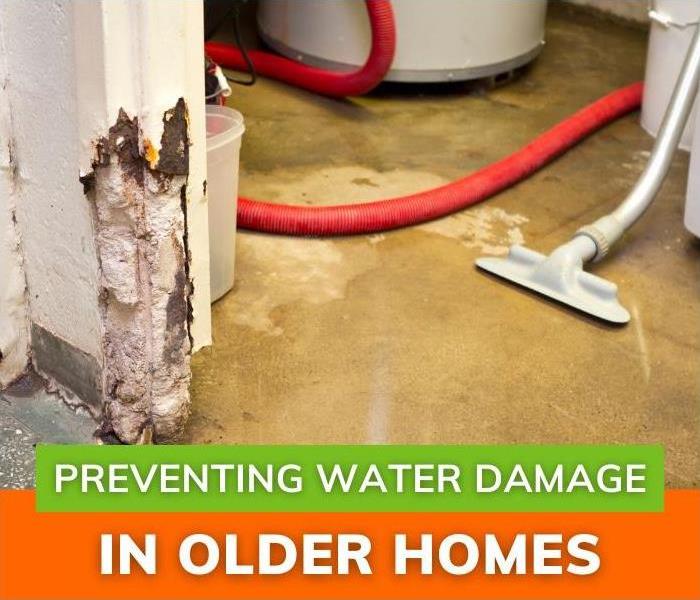 Prevent water damage in homes
Prevent water damage in homes
Preventing Water Damage in Older Homes
Choosing the perfect home involves a myriad of decisions and trade-offs. In many cases, purchasing an older home works because it satisfies many other requirements for home buyers. However, maintaining an older home requires essential steps such as inspections, which can reveal issues like existing water damage or faulty plumbing. Ensuring these problems are addressed promptly is vital to maintaining the structural integrity of older homes.
1. Regularly Inspect and Maintain Plumbing
Older homes are often beautiful buildings with a lot of history, but they can also include outdated plumbing systems built with aging components. Materials commonly used in older plumbing systems include galvanized steel or lead, which are prone to leaks and corrosion due to many years of use.
Preventing water damage in older homes starts with an annual plumbing inspection, which can catch minor issues in the plumbing system before they escalate into more significant problems. Discovering hidden leaks in the walls or underneath flooring can save the home or building from potential structural damage and keep mold from growing on materials that constantly remain wet. Replacing older pipes with modern plumbing that uses PEX or copper can improve the overall plumbing system and safeguard water flow throughout the house.
2. Inspect and Monitor for Signs of Concealed Water Damage
Getting to know an older home includes inspecting the walls, floors, and ceilings and keeping a vigilant eye out for signs of hidden water damage. Look for peeling paint, warped flooring, or brownish discoloration on ceilings and walls.
Monitor the utility bills to check for exceptionally high water usage or unexplained spikes in usage. Specialized tools like moisture meters or infrared cameras can help detect hidden leaks. Promptly addressing these issues can prevent escalating repair costs and damage.
3. Inspect the Foundation
The foundation underneath an older home may have experienced years of settling or cracking, which can lead to water seepage and related damage. Inspect the home's exterior and foundation, looking for visible cracks in the foundation's walls or floor.
To prevent seepage, treat minor cracks with a professional-grade sealant. Larger cracks may need to be addressed promptly with the assistance of professionals. Properly grade the surrounding yard areas and install appropriate drainage systems to ensure water drains away from the home's foundation.
4. Repair Sealing Issues in Doors and Windows
An older home's original windows and doors can become a significant source of intruding water, particularly during rainy seasons. Older doors may have gaps in their caulking or weather stripping, allowing water to seep underneath flooring or into walls. Caulking or new weather stripping can help close the gaps and keep water out.
Inspect the frames of doors and windows for damage or rot that can degrade them and lead to or worsen water leaks. Preventing water damage in older homes may require replacing older single-pane windows with updated double-pane or similar windows that offer better protection from moisture.
5. Install a Backflow Safeguard
Some homes have plumbing systems built without safeguards to prevent wastewater from backing up into the house. If this is the case, install a backflow valve to prevent sewage from backing up into the house. Regularly inspect the device to ensure it is functioning correctly.
Combine the backflow valve install with routine pipe inspections and maintenance, which is essential for homes with aging sewer systems or frequent heavy rainfall.
6. Check Hidden Areas for Mold and Mildew
Older homes often have hidden spaces, creating ideal conditions for mold and mildew to grow unnoticed. Inspect the home's attics, crawl spaces, basement, underneath sinks, and any other hidden areas, looking for discoloration or musty odors.
If moisture is detected, use a dehumidifier to remove dampness and keep moisture controlled. Additionally, address factors such as poor ventilation or uncontrolled moisture that may contribute to mold and mildew growth.
7. Upgrade Waterproofing in the Basement
Inspecting the basement in an older home may reveal inadequate waterproofing, making it a high-risk area for potential water damage. Basements and older homes often lack drainage systems or sump pumps.
Sealing cracks in the foundation is crucial to prevent water from intruding into the basement. Consider upgrading or adding a drainage system or a vapor barrier in the basement. If the area is prone to flooding or has frequent dampness, it may need professional waterproofing.
8. Monitor and Clean Gutters and the Roof
A home's roof and rain gutters serve as its first line of defense against water damage. However, older homes are more vulnerable due to aging structural materials. Roofs that have endured years of the elements may have missing, cracked, or worn shingles and damaged flashing, which allows water to seep underneath the roofing and into the home's attic and walls.
Clogged rain gutters can prevent water from moving correctly, leading to pooling at the roof level or flooding near the home's foundation. An annual roof inspection, with regular cleaning and repairs, especially after storms, can identify and prevent problems such as leaks and interior water damage.
9. Update Older Fixtures and Appliances
Preventing water damage in older homes includes appliance inspections. When certain appliances fail, they can cause leaks, flooding, and water damage. If a water heater is older than 10 to 15 years, it is likely due for a replacement. Additionally, inspect appliance hoses, such as those for dishwashers, for signs of wear or cracks. For high-risk appliances, install a water leak detector nearby.
If the home still retains its original plumbing, install upgraded, modern fixtures and appliances with built-in water efficiency. This move can reduce strain on the plumbing system and help prevent leaks and water damage.
10. Maintain Exterior Drainage Systems
Proper drainage in outside yard areas is essential for preventing water from pooling or coming inside an older home. Ensure that rain gutters and downspouts are positioned to direct water away from the home foundation.
For improved water management, install French drains or extended downspouts to direct water away from the home. Check the landscaping to ensure that the areas around the home remain appropriately graded. Avoid planting shrubs or trees with invasive roots near the foundation to prevent potential cracks.
Stay Ahead of Plumbing Problems
Ensuring the health of an older home's plumbing system requires proactive, routine maintenance and timely repairs to prevent expensive water damage. Regular plumbing and home inspections lay the foundation for preserving the property's structural integrity.
For multi-unit properties, partnering with SERVPRO®, the experts in commercial property maintenance, can help ensure the homes receive essential maintenance, water damage prevention, and professional, high-quality repairs. Contact us today to see how we can help!
Preventing Water Damage in High-Risk Areas
12/23/2024 (Permalink)
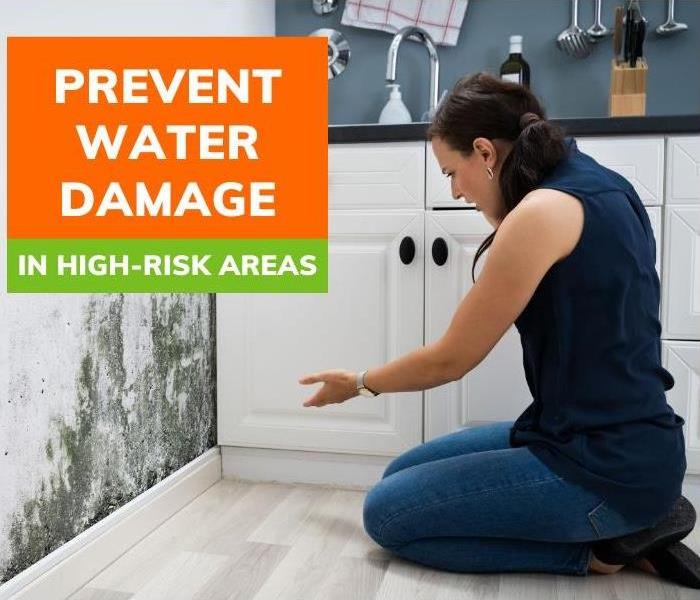 Woman Looking At Damaged Wall
Woman Looking At Damaged Wall
Preventing Water Damage in High-Risk Areas
Water damage is never a good thing, but some areas are at a higher risk of experiencing it than others. Whether you’re concerned about your home, a business, or another type of property, identifying high-risk areas and mitigating the potential for water damage can go a long way in preventing costly repairs and replacement.
If you haven’t given much thought to the threat of water damage around your property, below are some tips for preventing water damage in high-risk areas:
Complete a Visual Inspection
One of the first and easiest steps to preventing water damage in high-risk areas is to complete a visual inspection of your property to look for areas that may be more susceptible to moisture accumulation. These could include low-lying areas like basements and crawlspaces, exposed foundation elements, dips, gullies, or valleys around your greenspaces.
You can also check areas in bathrooms, kitchens, underneath sinks, around tubs and showers, and other areas at risk of water damage. Look for signs of water damage like mold or wood rot, and pay attention to the air in these areas. Mold growth often emits an earthy, musty odor, so if you detect this in wet areas, this can indicate moisture damage.
Remember that some damage can hide beneath flooring and behind drywall, so gently press on suspect areas. If they feel soft to the touch, this may indicate property damage underneath.
Have Leak Detection Services Performed
If you’re concerned about a water leak after noticing signs of water flow, hiring a professional to perform leak detection services may be a good idea. While you wait for a leak detection specialist to arrive, consider shutting off the main water to your home or business.
This can be done using the water shut-off valve, often located near the street, in a garage space, or a closet. If your leak detection expert needs the water supply turned back on, they will let you know, but turning off your water can prevent extensive damage.
Leak detection often involves completing a visual inspection of appliances that use water, like a sump pump, water heater, washing machine, or dishwasher. Your plumber will also use specialized tools and techniques that may involve sound waves and pressure monitoring to detect the location of any leaks.
Winterize Outdoor Plumbing
Outdoor plumbing components, including hoses, hose bibbs, and spigots, can freeze during the winter months, even in moderate climates. When water freezes inside pipes, it disrupts water flow, but it also causes a buildup of pressure that can lead to burst pipes and flooding. Homeowners' insurance may not cover flooding, meaning you may be left to cover the entire cost of repairs and cleanup if this occurs.
Burst pipes can be a problem even if freezing temperatures don’t reach your home or business. A hose can freeze if left out in cold temperatures, and if the hose has water in it, this can still cause back pressure on your plumbing system. By taking preventative measures like putting up hoses and insulating spigots, pipes, and hose bibbs, you can prevent structural damage by maintaining equalized pressure in your pipes.
If You’ve Experienced Water Damage
Although the above are some simple steps that can aid you in preventing water damage in high-risk areas, accidents can still happen. If you find yourself facing a situation where you have water damage, there are some dos and don'ts that can mitigate the fallout:
Do Dry Up as Much Water as Possible
Once the immediate cause of the water damage is dealt with, try to dry up as much water as possible as long as you can do this safely. Afterward, you will want to get a company like SERVPRO® involved since simply drying up water doesn’t necessarily mitigate hidden damage under carpets or behind walls. The company’s slogan is “SERVPRO like it never even happened” because restoration experts can completely restore your home or business after a water incident.
Don’t Wait to Seek Professional Help
If you’re going to seek professional help, whether from a plumber or a restoration company, don’t wait to make the call. Once water damage starts affecting the structural integrity of your home or business, you may be at a greater risk for accidents and injuries.
As problems like wood rot spread, they can weaken structures and lead to instability that may not present itself until days, weeks, or even months later. Getting a professional to address water damage quickly is often one key to reducing risks.
Do Clean Up Spills Quickly
Even a small water spill can lead to moisture damage if not resolved quickly. This can happen when water is spilled on carpet or non-treated wood. As moisture seeps into the material, it can cause mold growth and weaken its structure.
This is also the case in bathroom and kitchen areas where water may splash out of a bathtub, run out of a shower, or drip off of a counter. If you don’t have proper sealing around plumbing fixtures, baseboards, and other low-lying areas, repeated exposure to moisture can get inside cracks and crevices to cause damage.
Don’t Ignore Increasing Water Bills
One common indicator that you have a leak is a steady increase in your water bill each month. If you’ve noticed that you’re paying more and more for water, it’s a good idea to have a plumber investigate the issue.
Water leaks often get worse over time due to increasing pressure. Small holes or cracks succumb to water pressure, little bits at a time, allowing more and more water to come through. If these issues aren’t addressed, you’ll likely pay more for water each month, but you’ll also likely find yourself facing flooding in time.
Contact SERVPRO of Arcadia for Comprehensive Water Damage Restoration
If you’ve experienced water damage in the Arcadia community, contact the trusted experts at SERVPRO. Our team provides residential and commercial restoration services to secure your property after a water damage incident.
Long-Term Effects of Untreated Water Damage
12/4/2024 (Permalink)
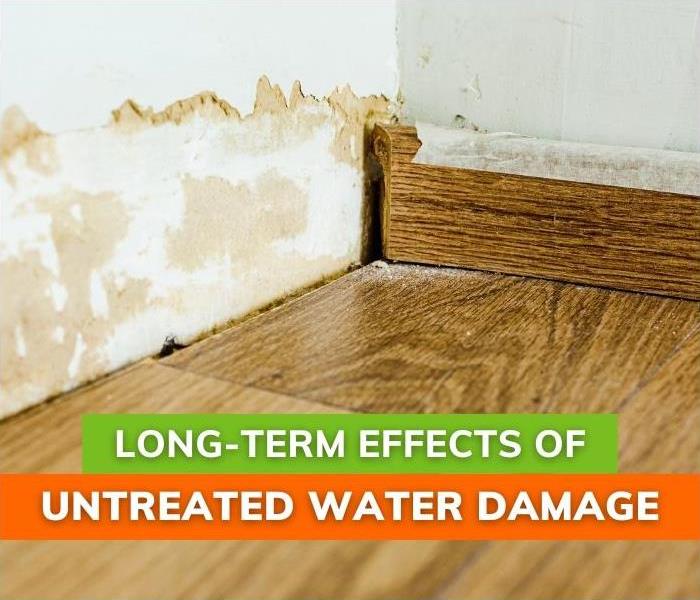 Water damage in the wall
Water damage in the wall
Long-Term Effects of Untreated Water Damage
Although water is an essential part of life, it also has the potential to cause harm. Nowhere is this more true than when water invades your home or business. Whether due to flooding, a leak, a major spill, or another water disaster, water damage can cause all kinds of short-term problems, but the long-term effects of untreated water damage can cause harm.
Before you ignore that dripping faucet in the bathroom or leaky pipe under your home, consider the following potential consequences of long-term water damage:
Wood Rot
Wood is used worldwide in the construction industry. While it is a great building material for homes and businesses, it is susceptible to rot when exposed to sustained moisture. Wood's porous nature means it absorbs water like a sponge, and even treated wood can be at risk when exposed to enough water over time.
As wood becomes saturated with moisture, it loses hardness and becomes pliable. When this occurs, the wood structure breaks down, leading to wood rot. This rotting effect causes water-damaged wood to fall apart over time, often leading to the next biggest long-term effect of untreated water damage: structural instability.
Structural Instability
Structural instability caused by moisture damage and wood rot can be a serious concern, both for your property and your safety. To make matters worse, you must repair this damage and mitigate the problem if you plan to sell your property. Potential buyers are likely to shy away from a property with known water damage or ongoing problems with water mitigation.
The insidious thing about moisture damage and structural integrity is that this damage can create a domino effect. As structural pieces of a home begin to weaken, they can shift and place weight on parts of the structure not designed to hold.
For example, if your flooring has moisture damage and begins to buckle, the foundation of your walls can shift. When this happens, the foundation for your roof can shift. As the weight of the various parts of a structure begins to jostle, this shifting weight can upend the structural integrity of parts of a home or business that never even experienced water damage directly.
Mold Growth
Even if you don’t experience wood rot that leads to structural instability, mold growth is another one of the major long-term effects of untreated water damage. This is especially true if you have people in your home who have compromised immune systems or respiratory issues.
Although not all mold is dangerous, even a little can cause allergic reactions. As mold grows and spreads in moist, dark environments, it can take over interior spaces and lead to more serious health problems. So-called “black mold” is often cited as a serious concern, but for most people, black mold will not cause any greater harm than any other type of mold. For people with severe allergies, however, black mold can cause serious illness.
While some water damage is easy to see, mold can grow silently in cracks and crevices, inside porous materials, under flooring, behind walls, and elsewhere. This means that even if you clean up surface mold, you may still have a problem on your hands. To complicate things further, individual mold spores are microscopic, so you can still have mold spreading throughout your home after water damage, even if you’ve cleaned surfaces with visible mold.
Insects and Vermin
Moisture is also a primary driver of insects and vermin. Just like humans, bugs and pests need water to survive. The difference is that people use the sink or visit the grocery store for water. Bugs, on the other hand, invade spaces where water is found. If this is your home or business, guess what? You may have an infestation on your hands, including termites!
Unfortunately, it may not be obvious initially, like mold, bugs, and vermin. Insects, mice, and more can squeeze through cracks and build nests in hidden places. While you think you’ve cleaned up water after a pipe burst, you may have a colony of bugs living beneath your floorboards, feeding off of leftover moisture in your wood.
In addition to being unsightly and uninvited, bugs and vermin can pose a health hazard to you and your loved ones. Health issues arising from insect and vermin infestations can range from mild to severe, and once pests make your home their own, they can be tough to get rid of.
Potential Future Damage
Lastly, future damage to your home or business may be risky due to water damage. Electronics and electrical systems that come into contact with water may not seem damaged at first glance, but water may corrode and weaken internal electrical connections. As water and electricity do not mix, a damaged electrical system may cause an electric shock or fire.
How to Prevent Water Damage Around Your Home or Business
Although it may not be possible to prevent water damage in an emergency, there are some steps you can take to prevent and deal with damage caused by moisture. First, look for signs of water damage. These can include discolorations on walls and flooring or the smell of mold in the air around your home or business.
Next, excess water should be cleaned up as soon as possible after damage has occurred. Addressing water damage quickly often offers the best chance to resolve and mitigate damage fully. However, remember that hidden moisture may lurk within your walls, carpeting, or other flooring, crawlspaces, basements, and attics.
Because water damage isn’t always obvious, you’re encouraged to partner with a restoration expert who specializes in addressing water damage if you’ve experienced a leak or flooding incident. A professional water damage company can clean up messes left behind and restore your home or business to its original condition. Restoration specialists also typically check for hidden damage to offer additional security and peace of mind.
Contact the Water Damage Experts at SERVPRO of Arcadia for Fast Relief
SERVPRO® is the team to call when you need the experts in water damage restoration Arcadia trusts. Our team specializes in removing moisture and restoring your home or business to its original condition. Still, we also mitigate damage from the water you may not see, including behind walls, under flooring, and more.
Best Practices for Water Damage Restoration
11/13/2024 (Permalink)
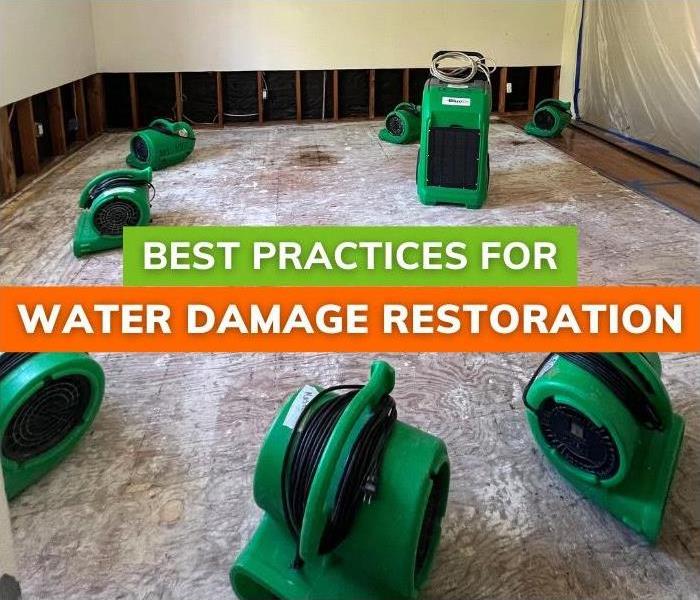 Fixing water damage with fans
Fixing water damage with fans
Best Practices for Water Damage Restoration
Water damage can quickly grow from a minor issue to a major problem if not handled quickly. Taking immediate steps using the best practices for water damage restoration will help you prevent further complications like mold growth or structural damage.
1. Timing Is Crucial
When responding to an incident involving water damage, each passing moment could allow more water to seep under flooring, absorb into drywall or insulation, or saturate carpeting and furniture. The longer building materials and belongings remain wet, the more damage occurs, such as warping and swelling.
Mold, mildew, and bacteria may start to appear within 24-48 hours on wet surfaces. Immediately identifying the water source and stopping the flow is the best way to minimize further complications, damage, and repair costs. Quickly catching damage can also preserve valuable belongings that might otherwise become unsalvageable.
2. Put Safety First
Depending on the degree of water damage, affected areas could become a safety risk, which requires making them safe to inhabit before any restoration work begins. It is essential to be aware of potential fire damage and safety concerns. Best practices for water damage restoration begin with turning off the electricity to prevent dangerous fire hazards from wet wires or outlets. Take precautions to prevent electrocution and wear protective gear such as masks, boots, and gloves to avoid contamination from contact with bacteria and mold.
Before entering, assess the structure’s stability, considering ceilings, walls, and floors. If there is any risk of the structure collapsing, evacuate the building. Additionally, be cautious of sharp debris, slippery floors, and other hazards that may have been created due to excess water.
3. Locate the Source of the Water
When starting the repair and restoration process, it is critical to know the type of water and where it is coming from. Clean water from broken pipes has less associated risk but should still be handled quickly. Grey water from appliances is potentially more hazardous because it can contain bacteria or chemicals.
Black water is considered a biohazard, and it comes from sewage leaks and other sources that can pose significant health risks to building occupants. Stopping water flow is essential to prevent further damage and other issues. Identifying the source and performing needed repairs first prevents recurring water issues during the structure's restoration process.
4. Remove Standing Water
Any standing water should be immediately removed to limit damage inside a building. Water pumps are effective for large amounts of water, while wet/dry vacuums are often more effective for smaller areas. Quickly extracting water can significantly minimize damage, especially to wood floors, carpeting, and walls.
Remember that hidden areas, such as crawl spaces and basements, also need water removed. To prevent mold and mildew growth, be especially thorough and ensure all spaces are dried out.
5. Assessing the Damage
A comprehensive assessment is necessary for insurance claims and restoration planning. Before starting any restoration work, it is essential to document the damage by taking videos and extensive photographs of water-damaged areas. Be sure to record the extent of the water damage to understand its total reach and where repairs are needed.
Include documentation on materials that are too damaged to repair, such as warped flooring, drywall, baseboards, and carpets. While documenting, create a detailed list that includes all the affected items that need repairs or replacement for insurance purposes. Having this proper documentation will become critical for navigating insurance claims later on.
6. Remove Unsalvageable Materials
Depending on the scale of the damage, some materials will not be salvageable and must be discarded. For drywall, it is essential to cut out and remove water-damaged areas at least 12 inches above the line where the water level shows. Water can soak deep into the drywall, and the damage may be more extensive than it appears. If carpet is soaked, it must be discarded, especially if exposed to gray or black water, due to bacteria and other contaminants.
Inspect the building's insulation in the walls and attic because it can absorb water like a sponge. Even if the wetness does not show in the drywall, insulation can remain wet and harbor mold growth if not addressed. Flooring that has become weakened, damaged or warped must also be removed and replaced. It is also essential to evaluate the building's wooden structural components, such as beams and studs, for any signs of rot.
7. Drying and Dehumidifying the Area
Effective drying and moisture removal are essential to curbing additional damage and preventing mold and bacteria growth. Larger, industrial-strength fans and dehumidifiers can quickly and effectively reduce moisture levels. Open the structure's doors and windows to increase airflow, speeding up drying.
Hidden spaces like walls, subfloor, and ceilings need special attention to ensure no moisture remains. Before proceeding with restoration work, use moisture meters to confirm that the building areas are thoroughly dried and ready for work. The drying could take several days, so continue with fans and dehumidification until all the materials are moisture-free.
8. Cleaning and Sanitizing
Clean and sanitize any areas that have been water-damaged to eliminate contaminants. Effective disinfectants must be used to clean surfaces exposed to gray or black water. Ensure that walls, furniture, and floors are cleaned and sanitized to remove bacteria and mold spores.
Focus additional attention on areas where bacteria thrive, such as kitchens and bathrooms. HVAC systems can also spread contamination, so remember to disinfect them and change the filters. Use safe and non-toxic cleaning solutions, especially for areas used by people and pets.
9. Preventing Mold Growth
Preventing mold growth is a vital step in restoration after a structure sustains water damage. Acting quickly to dry out all moisture is essential because mold thrives in damp conditions. Clean areas that sustained water damage with mold-killing products, wiping down all surfaces and materials that became wet.
Best practices for water damage restoration include using an antimicrobial spray to prevent mold growth in affected areas. Porous materials like drywall and carpet are susceptible to mold growth and should be removed and replaced. Additionally, although areas may seem dry, monitor water-damaged areas for signs of mold for several weeks after the incident.
10. Inspect for Structural Damage
Water leaks, floods, or pooling in a structure can compromise the building's integrity, necessitating an inspection and potential repairs. Check all load-bearing walls and beams for signs of weakness or indications of rot.
Inspect the building's foundation for any shifts or cracks that changes in water pressure might have caused. If water damage has weakened floors, walls, or ceilings, they may need additional reinforcement during restoration efforts. Replace any damaged electrical outlets or wiring that were exposed to water. Finally, it is a good idea to hire professionals to ensure the repairs and restoration work meet building safety standards.
11. Restoration and Insurance
Once the structure has dried out and passed a safety inspection, it is time to begin restoring and replacing damaged contents. Ensure all salvageable items, such as furniture and appliances, are clean, checked for safety, and dried. If the building contained upholstered furniture or bedrooms sustained water damage and mattresses got wet, they most likely need replacement due to mold or other contamination.
If water damage has affected essential documents and photos, professional restoration services may help restore them or create copies. Partnering with professionals ensures the restoration process is effective and smooth. The insurance company may be able to provide a list of providers. Contact them early to begin a claim and get additional guidance on how to move forward.
Keep detailed records of all repair costs, including materials and labor expenses. For more extensive or complex jobs, work with a certified water damage restoration company. After speaking with the insurance company, ensure that contractors understand the insurance procedures to coordinate the project seamlessly. Regularly communicate with the restoration team and insurance company for updates and additional guidance or advice.
Stop Water Damage in Its Tracks
When you are dealing with water damage, time is of the essence. Taking quick action can limit the damage and prevent long-term problems. Proactive measures also prevent more minor issues from turning into costly projects. Start the restoration process quickly to protect your property and ensure the safety of your commercial building or home. Turn to SERVPRO of Arcadia when you need professional, experienced water restoration specialists. Call us for more information today!
Effective Strategies to Prevent Water Damage in Retail Centers
8/26/2024 (Permalink)
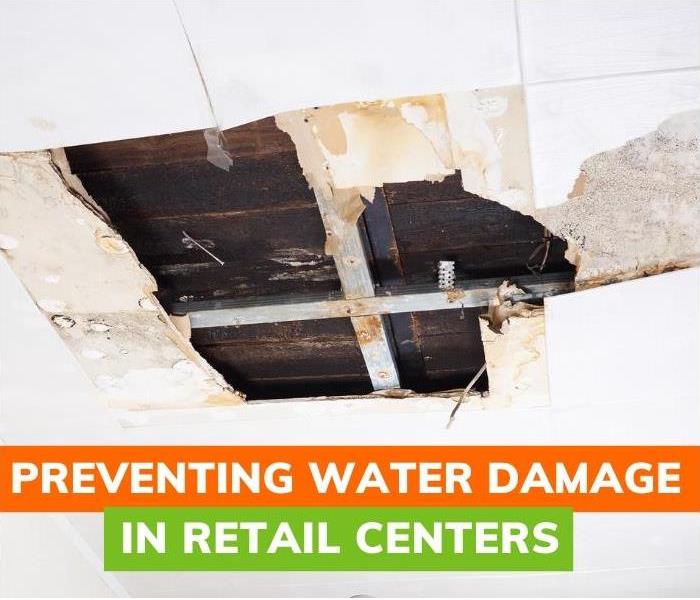 Ceiling Water Leak Damage
Ceiling Water Leak Damage
Effective Strategies to Prevent Water Damage in Retail Centers
Despite the Internet taking a sizable portion of retail in the modern economy, retail centers are still key sources of goods for many consumers. Shopping centers, malls, and mixed-use areas that house retail outlets provide access to everything from clothing to specialty items, and commercial property managers who oversee retail centers typically stay quite busy throughout each work day.
Protecting Retail Centers From Threats
In addition to administrative and managerial tasks, security and protection are heavily influenced by retail center management. Threats can come from just about anywhere, but water damage is often one of the largest concerns.
Moisture can potentially cause serious property damage that requires costly repairs, modeling, or rebuilding. Water damage in a retail center can also weaken structures, turning them into hazards and liabilities for workers and shoppers.
The good news is that there are some steps you can take now to prevent water damage inside retail centers you manage. Below are some tips for commercial property owners and retail center managers:
Conduct Routine Inspections
One of the best ways to prevent water damage inside retail centers is to stop the damage before it has a chance to turn into a disaster. Regular inspections of commercial buildings can help you spot potential threats, so take some time to tour your property looking for signs of water damage like water stains, rain coming in from open skylights, other building systems with issues and roof leaks.
If you notice standing water with no apparent source, it may be time to contact a plumbing professional to inspect the area. Water leaks don’t always make themselves known at first. Over time, however, they will almost always get worse, and tell-tale signs of a water leak can include wet flooring and walls.
You can also create an inspection routine and include it in your employee training materials. This gives employees instructions on what to look for that may indicate water damage.
Install Smart Sensors
Many homes worldwide use automated smart technology to regulate indoor climate and monitor security cameras, but retail centers can also use smart technology to monitor for water intrusion and flooding. Water sensors are devices that connect to the Internet and can be installed in remote locations. When they encounter moisture, they send a notification to your smartphone or other connected device to alert you to the possibility of danger.
Although a smart sensor doesn’t necessarily prevent water damage from happening completely, it can help mitigate the damage by alerting you to the problem early. This may give you enough time to respond to the situation and take care of it before flooding and property damage occur.
Use Sump Pumps Where Appropriate
Sump pumps and other drainage technologies should be installed in areas vulnerable to flooding. These areas typically include low-lying sections of retail centers, but areas like kitchens, bathrooms, cleaning stations, and processing areas where water is used can also benefit from having a sump pump nearby. These devices activate when moisture enters a low-lying area and automatically pump out excess water to a safe location.
Drain areas should also be maintained to prevent clogs and obstructions from creating blockages. Because water damage can happen slowly over time, a blocked drain may not be a big issue at first. As moisture builds in a confined area, backups caused by blocked drains can cause the water to spread to nearby wires, electronics, walls, furniture, and more. This can lead to structural weakening, the risk of fires, and slip-and-fall hazards.
Apply Waterproofing Where Necessary
Waterproofing areas vulnerable to moisture can prevent damage in many cases. Waterproofing may involve applying coatings to areas like walkways or below-grade areas, but it can also mean simply placing sandbags or other moisture barriers around a specific area.
When you put waterproofing in place, consider having the job completed by or, at the very least, inspected by a professional. Although there are plenty of consumer-grade products available at hardware stores that can be easily applied to create a moisture barrier, these are generally not suited to protect commercial interests. A professional waterproofing company can evaluate your commercial property, discuss custom solutions, and put waterproofing measures in place to protect sensitive areas.
Develop or Refine an Emergency Response Plan
In keeping with the above, develop a response plan if water damage is found during an inspection. Flood control should be a top priority in this plan, especially in areas vulnerable to water, such as electrical systems or retail centers where customers spend time.
Your emergency response plan should include the location of shut-off valves for your property’s water supply and HVAC equipment vent locations. You can also detail clean-up procedures for minor spills, but professional water clean-up is generally recommended for large amounts of moisture in commercial buildings.
Get Established With a Restoration Company
Lastly, although the above steps can help prevent water damage inside retail centers, accidents, and emergencies can and do happen. This is why it would be a good idea to get established with a reliable restoration company in the event that something like a sudden storm, major water leak, or burst plumbing pipe causes water damage.
Water damage restoration companies like SERVPRO® help business owners and commercial property managers quickly mitigate the effects of water damage and restore commercial properties. While the hope is that you will never need to utilize the services of a restoration company, establishing a relationship with one now can save you time, money, and frustration in the event that water intrusion occurs in the future.
Contact SERVPRO of Arcadia for Fast Help in a Water Emergency
SERVPRO of Arcadia is the team to trust when you need commercial restoration services following water, fire, or smoke damage. Our team helps commercial property managers return to operations faster, and we’re also happy to provide more tips to prevent water damage at your retail store.
Ways to Prevent Water Damage in Apartment Buildings
7/29/2024 (Permalink)
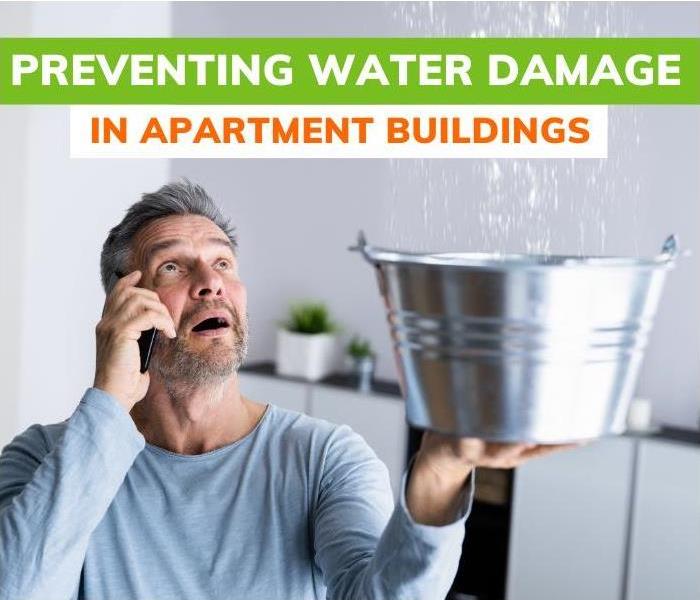 A man holding a bucket of water
A man holding a bucket of water
Ways to Prevent Water Damage in Apartment Buildings
Preventing water damage to apartment buildings is one of the top priorities of property managers, as water damage can be costly. Aside from the initial damage caused by flooding or plumbing leaks, water damage often produces hidden damage that may not be noticed or felt for weeks, months, or even years.
How Water Damage is Insidious
As wooden surfaces absorb moisture, they can become saturated, allowing the wood to rot over time. This weakens the structural elements of apartment buildings and potentially jeopardizes the structural integrity of accommodations.
Furthermore, moisture damage can cause soil saturation and erosion, which may lead to foundation issues over time. Moisture can also lead to uneven walkways, which may threaten workers and tenants in and around multi-family properties.
Additionally, moisture that makes its way to areas that house electrical components can also become compromised with rust and corrosion. The effects of moisture damage on electrical components sometimes result in shortening circuits. Still, in some cases, it can lead to the creation or arcing that results in severe electrical shocks and apartment fires.
Because of the dangers listed above, preventing water damage to apartment buildings should be at the top of your list as a property manager after a natural disaster, burst pipe incident, or any other situation involving moisture and flooding.
Seek an Inspection After a Water Event
If you’re concerned about damage after a water event, it’s important to inspect affected areas professionally, even if you don’t see any apparent damage. As mentioned, water damage can sometimes be hidden in plain sight. While walls, flooring, and ceilings may look okay from the outside, structural damage may be in, and an upstairs neighbor may be getting ready to fall through the floor to the unit below.
Another advantage of having an inspection done early is quickly performing mitigation and restoration services. After a fire event where apartment sprinklers have gone off, a fire damage restoration service can inspect the area for both outward and hidden damage to provide recommendations and solutions. Professional restoration services often use advanced tools and training to spot areas of damage that may not be outwardly visible but can still lead to structural instability.
Contact Your Insurance Company
It’s also vital to contact your insurance company immediately following an event that causes water damage. Many commercial insurance companies require customers to file a claim within a specific amount of time after an event, and written notice may also be required. By contacting your insurance provider early, you may have an easier time dealing with water damage and receiving coverage for costs incurred.
It’s also a good idea to encourage tenants of a damaged apartment building to contact their insurance providers. Many people who lease apartments have renters’ insurance. While these are usually separate policies independent of your insurance coverages, you can make life easier for everyone when coverage claims start early.
Review Your Maintenance Policies
Regular maintenance is another way to prevent water damage to apartment building structures. Although some water events happen at a moment’s notice due to natural disasters or burst pipes, others occur due to neglect of plumbing and safety systems.
You likely already have a maintenance schedule to inspect and maintain these systems, but it may have been a while since you’ve reviewed it. This can lead to gaps and lapses, especially if changes have been made to your property over time.
By taking some time now to review and amend your maintenance plan, you stand a better chance of staving off water damage before it occurs. As a bonus, this can also allow you to look for and weed out inefficiencies.
Don’t forget to include HVAC and plumbing equipment inspections as part of your maintenance. While inspecting the structural integrity of your buildings is important, remember that leaking AC units or plumbing pipes can lead to water damage over time. This type of damage is often the hidden type mentioned previously.
A leaking plumbing pipe in a building's basement or crawlspace may take weeks, months, or longer to cause damage. Regular and thorough inspections can catch these problems early, allowing you to prevent serious damage.
Update Your Training
In addition to updating your maintenance policies, it is also a good idea to update your training. In many cases, the first step in preventing water damage to apartment buildings is having the right training so that workers know how to handle water emergencies.
In your policy manual, clearly spell out the chain of command for reporting potential water damage and the steps workers must take to mitigate damage safely. Remember to include steps workers should take to protect tenants, their property, and common areas where tenants may gather. These steps can help you avoid lawsuits for injuries or breach of lease agreements.
Work With a Mitigation and Restoration Professional
If you spot water damage, you’re also encouraged to work with a professional mitigation and restoration company. While your maintenance staff may be able to handle some repair and restoration jobs, a professional mitigation and restoration company will usually be able to provide more comprehensive service. Dedicated restoration services may also be covered by your property’s insurance policy, allowing you to quickly get the damage under control without spending a lot out of pocket.
Contact SERVPRO of Arcadia for Fast Solutions After Water Damage at Your Apartment Building
If you’re concerned about water damage at your apartment building, SERVPRO of Arcadia is Here to Help®. SERVPRO® water damage specialists provide inspection and restoration services to mitigate damage to commercial properties caused by water, smoke, fire, and more.
Ways to Prevent Water Damage After a Leak
1/17/2024 (Permalink)
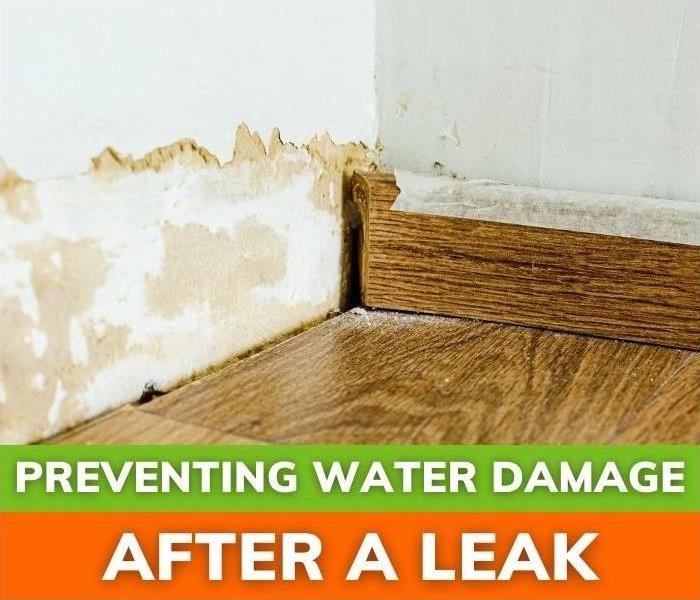 Learn how to prevent water damage effectively after a leak in your home. Essential tips to safeguard your property and avoid costly repairs. Act now!
Learn how to prevent water damage effectively after a leak in your home. Essential tips to safeguard your property and avoid costly repairs. Act now!
Preventing Water Damage After a Leak: Expert Tips
Plumbing leaks are some of the most common problems in homes and businesses across California and the U.S. While some leaks are only mildly annoying, others can turn into plumbing disasters, resulting in water damage, wood rot, and expensive property repairs.
According to data from the Insurance Information Institute, as reported by This Old House, close to 15,000 homeowners across the country experience the effects of water damage daily. The average insurance claim for water damage is somewhere in the neighborhood of $12,000, meaning this type of damage is not trivial when it comes to your wallet.
Preventing Water Damage When Faced With a Leak
The good news is that there are ways to prevent water damage after a leak. In virtually all cases, the sooner you address a leak, the better your chances of preventing water damage, but it’s always important to take some action. Leaks tend to get worse over time; even a small leak can become a flood if left unaddressed.
If you’re concerned about protecting your property, below are some ways to prevent water damage after a leak:
Call a Professional
Often, the best way to stop water leaking into walls and floors is to contact a professional at the first sign of trouble. Some signs of water damage can include damp carpets or water stains on walls, but you may also notice mold growth along baseboards or a musty, moldy smell in the air.
If you believe that you have mold growth, you may need more than just a plumber. While a plumbing company can deal with the leak itself, a mold damage company is going to be the solution for water damage repair involving mold growth. These companies may also help remove water pooling after a serious leak or flood, but you will need to ask your mold remediation technician about this option when you schedule service.
Turn Off Your Water
If you can’t get a professional to your home quickly, you will want to stop leaking water at the source. This usually involves turning off your home’s main water supply, often located under a grate in your yard or at a shut-off valve in a garage, closet, or basement. This can be a good option when you can’t determine how water enters your home.
For example, you may have a leak in your water heater, but that water heater may be located in an area of your home that isn’t easily accessible. Without the ability to check for standing water around your water heater, choosing to shut off the water until a professional can address the situation is often the best idea. Water leak detection services utilize specialized equipment to track down the source of leaks so that targeted repairs can be made.
Contact Your Insurance Company
Your home insurance policy may cover water damage, but this varies from provider to provider and policy to policy. Flood insurance covers serious water damage caused by major leaks in some cases, but you will likely need to add this as special coverage as most general homeowners’ insurance policies don’t include flooding under general claims. Although flood insurance will not directly prevent water damage after a leak, it may cover the cost of repairs related to water damage caused by a leak.
Unfortunately, you can’t add flood insurance retroactively, so you must weigh the pros and cons of carrying this coverage. For many homeowners, the cost of additional flood insurance is worth the peace of mind that comes with knowing that you won’t have to worry about expensive repairs in the event of a water emergency.
Check and Maintain Your Plumbing on a Scheduled Basis
It’s also a good idea to check and maintain your plumbing on a regular basis. Older hoses for things like washing machines that get used often tend to develop leaks after many years of service, and changes in water pressure inside plumbing pipes can cause joints to loosen and leak over time.
By checking and maintaining your plumbing pipes, hoses, and fixtures, you can prevent water damage caused by leaks. Remember that leaks typically cause structural damage slowly over time, and it can be easy to miss signs of damage until something major happens. You can protect your home by creating a plumbing maintenance schedule or having a professional plumbing company maintain your home’s plumbing system.
Install Sensors and Sump Pumps
You can also consider installing wireless sensors to help you get notified of leaks, standing water, and flooding. These devices measure water flow and pressure and can send alerts to your smartphone if a leak or flooding has been detected. Moisture detection sensors may be placed around areas where pipes are located but can also be placed in bathrooms and kitchens.
A sump pump may also be a good idea if you have a basement. These devices automatically pump out excess moisture in low-lying areas of your home if flooding occurs after a leak becomes serious. As an added benefit, sump pumps can prevent flooding in basements during heavy rainfall if moisture seeps into basement areas of your home.
Vigilance is the Key
Although water damage following a leak can seriously threaten your home's structural integrity, vigilance can prevent disasters. By checking your plumbing often, watching for signs of water leaks, and partnering with professionals at the first sign of trouble, you stand a better chance of protecting your home and your health. If you do experience a leak, taking care of it quickly can typically prevent serious damage from occurring, but it’s always a good idea to have a professional check questionable areas for your own peace of mind.
Contact SERVPRO in Arcadia for Fast Restoration Services for Water Damage
If you’re concerned about water damage following a leak in Arcadia, CA, SERVPRO of Arcadia is here to help with comprehensive residential restoration services. Our team of experts is available 24 hours a day.
Water Damages in the Summer
6/16/2023 (Permalink)
Summertime: the season of sunshine, barbecues, and family vacations. However, for many homeowners, it can also be a season of unexpected water damage. Whether from unpredictable storms, increased humidity, or HVAC system leaks, summer brings its own set of water-related challenges.
While rainstorms are usually less frequent in summer, they often come as heavy downpours that can quickly overwhelm gutters and seep into basements. Regularly cleaning your gutters can mitigate this risk, but sometimes the volume of water is simply too much to handle. In these cases, our team at SERVPRO of Arcadia is here to assist with swift and comprehensive water damage restoration services.
Additionally, your air conditioning unit can be a significant source of water damage in the summer months. With constant use, the condensation line can easily get blocked, leading to leaks or even a full-blown flood. Regular maintenance checks are crucial to prevent such situations.
But, when the unexpected does occur, don't despair. Our expert team has the skills and technology to handle any water damage situation. We offer efficient drying, cleaning, and restoration services, using state-of-the-art equipment to ensure your home is returned “Like it never even happened” and as quickly as possible.
Remember, water damage doesn't take a summer vacation, but with proactive measures and a reliable restoration partner in SERVPRO of Arcadia, you can enjoy a worry-free season.
How does SERVPRO handle my items
3/2/2022 (Permalink)
When a water damage occurs it not only can destroy the structure of your home but your precious belongings may be affected also.
Our skilled team here at SERVPRO of Arcadia take the time to restore your belongings as best as possible.
Here are a few ways in which we do this:
Dry Cleaning - Used for cleaning light residues or to pre-clean prior to wet cleaning.
- Wet Cleaning - An effective cleaning method for removing moderate to heavy residues.
- Spray and Wipe -Effective for items that can’t withstand wet cleaning.
- Foam Cleaning - Used for upholstery fabrics that might shrink or bleed if wet cleaned.
- Abrasive Cleaning - Involves agitation of the surface being cleaned.
- Immersion Cleaning - Contents are dipped into a bath of the cleaning product.
For more in depth information on how we clean your items please check out https://www.SERVPRO.com/resources/water-damage/your-belongings-and-water-damage
What Causes Water Damage?
11/9/2021 (Permalink)
There are many different ways a water damage can occur in your home, from a broken pipe to a/c systems. We do ours best to maintain our home items but sometimes the inevitable happens.
Here are the top 5 causes of water damage:
- Leaking or Busted Pipes
- Plumbing Issues
- Faulty Household Appliances
- HVAC Units
- Clogged Gutters
Some less likely, but still possible causes of a water damage can be
- Toilet Overflow
- Sewage Back-Ups
- Laundry Washer Overflow
While for the most part it sounds easy to be able to maintain these house hold items, sometimes we can not help it when accidents happen. So in the event something like this happens to you, SERVPRO will always be there to help, anytime, anyplace, 24/7.
Laundry Room Overflow
10/21/2021 (Permalink)
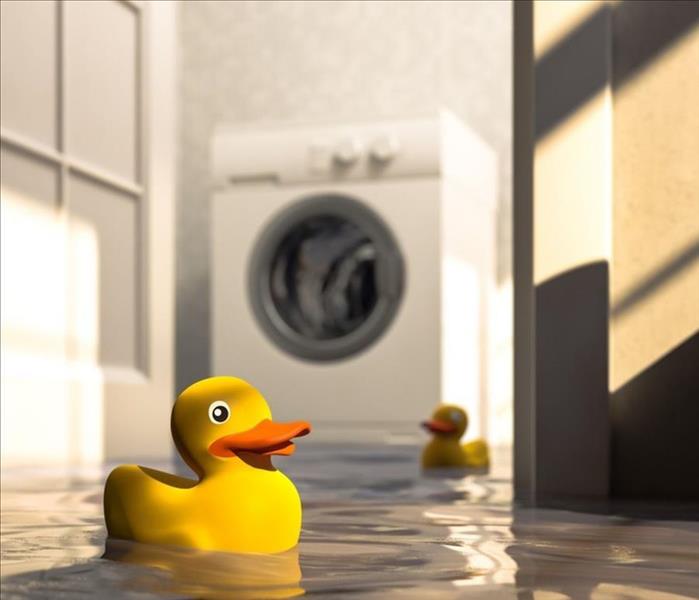 We can help with laundry room floods!
We can help with laundry room floods!
In your daily lives we do our best to maintain our homes to keep them in tip top shape. We clean the restrooms, the kitchen, and all bedrooms keeping them spotless. Most times we forget all about the laundry room! Which should be the most important room to maintain because many problems can arise in that room alone!
Most water damages we see here at SERVPRO of Arcadia come from the washing machines drain line bursting in laundry rooms. This can be caused by a number of reasons.
What to do if this happens to you:
- Contact your local plumber to repair the line
- Remove any personal items from affected area
- Depending on extent of damage, it is advised to file a claim with your insurance company
- Contact SERVPRO of Arcadia to mitigate these damages
Refrigerator Line Leaks
10/21/2021 (Permalink)
Do you have a rodent problem in your home? Rats and other pesky rodents can do more damage than stink up your home and eat food that has been left outside. SERVPRO is not a rodent control company but we do deal with the aftermath of what rodents can do to your home!
Rats, often times hide in small dark area away from the people in the home. Particularly behind your refrigerator, and that is where the important water and power lines come from. If a rat gets caught back there it can start chewing on the water line day after day. You might not even realize until it's too late!
If the rat chews at the water line long enough it can cause a leak that will eventually create flooding and water damage to your kitchen floors!
That's where we come in and clean up the water and repair the damage.
Fire Sprinkler Disasters
10/20/2021 (Permalink)
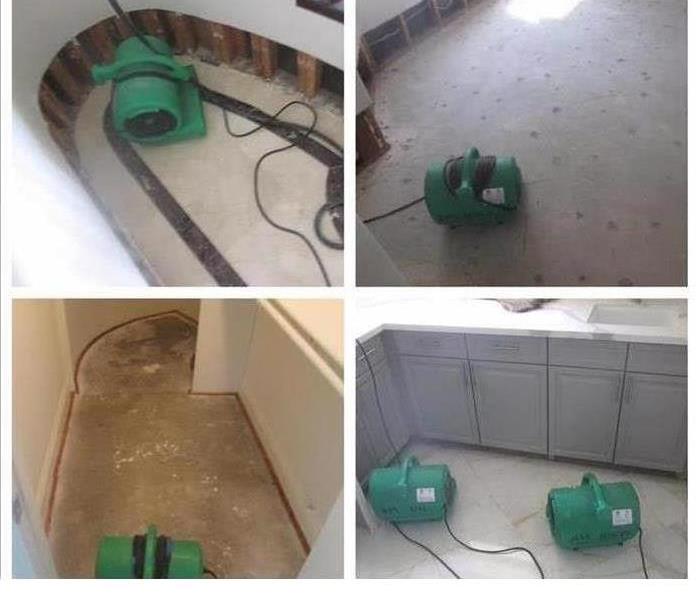 Water Loss due to Fire Sprinklers
Water Loss due to Fire Sprinklers
Imagine coming home to a flooded disaster after being on vacation with the family! That's exactly what happened to our customer here in Arcadia. This loss was caused by a faulty fire sprinkler system. To make matters worse the homeowner had just purchased the home prior to leaving on vacation. It is a good thing that they acted swiftly and contacted us! Our crew was able to be onsite within the hour of being notified of the loss and quickly jumped into action.
With the home having high moisture levels, our crew was able to effectively dry the structure within 5 days. By doing so we were able to save the structure from experiencing secondary damage such as mold. We at SERVPRO of Arcadia do our best to achieve the industry standard of drying within 3-5 days.
Most Common Water Damages
10/5/2021 (Permalink)
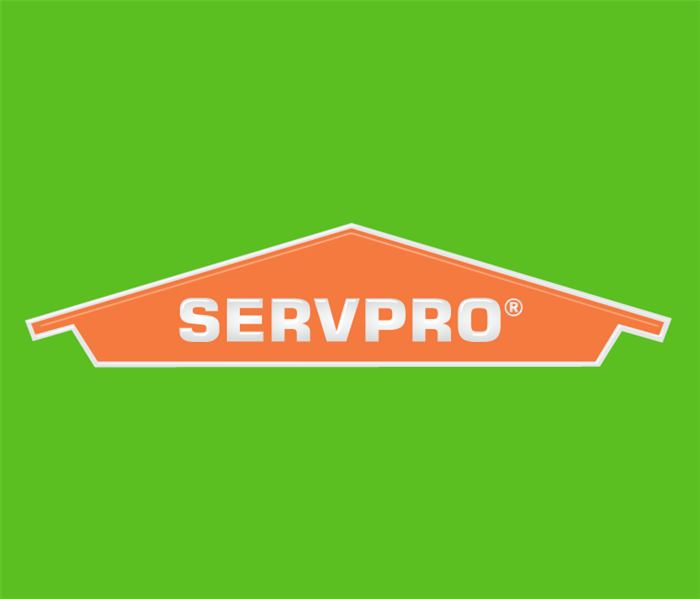 SERVPRO Heroes here to help
SERVPRO Heroes here to help
Water damages can be very overwhelming and frustrating for the typical home owner. We understand that it can become stressful as water damage experts we are here to help bring your home back to life!
Here are some typical causes of water damage:
- Leaking appliances, plumbing issues, water heaters etc.
- Over flowing bathtubs, toilets, and sinks
- Flooding from firefighting efforts
- Flooded basements
- Roof leaks
Here is what you can do while you wait for our SERVPRO crews to arrive:
- Shut off water valve
- Contact Plumber
- File a claim with your insurance company (if needed)
- Grab yourself a warm cup of coffee, step outside and destress knowing that you will be in good hands while you wait for our crews to arrive with help very soon!
We are available 24/7 to respond to your emergency! Call SERVPRO at (626) 447-4128
For even more info on water damage check out
https://www.SERVPRO.com/water-damage-restoration
Cupped Floor
2/25/2020 (Permalink)
Hardwood and laminate flooring are a bit more complicated to maintain compared to ceramic tile. One must remember to only use limited cleaning solution to prevent the floor from absorbing to0 much liquid. The reason being that leaving a liquid on the surface for an extended period of time can lead to “cupping” also known as “edge-warping." Floor “cupping” or edge- warping” can be reversed if the wood is dried in a timely manner, if it remains moist it can lead to irreparable damage such as staining, wood-rot, mold growth, and "buckling." There are a few visual and physical cues that will let you know the floor is damaged. Visually, the edges of where the wood floor links together will be rising like how tectonic plates meet to form a mountain, also known as "cupping." Physically, when you walk over the floor it will feel unleveled and "bumpy."
Precautions to take when maintaining wood flooring
- Control and limit how much liquid is used when cleaning the floor
- Keep diligent and dry up any accident spills as soon as possible
- Do not place plants that must be regularly watered on top of the flooring
Are you prepared?
2/25/2020 (Permalink)
No one ever expects to experience water damage in their home or place of business. Unfortunately, disasters happen when you least expect them. At SERVPRO of Arcadia we understand that water damage can be stressful on you and your family. That is why we do our best to take that pressure off of you, by providing you with an Emergency Ready Profile.
You do not except a pipe to burst in your home or place of business. However, you can be proactive and stay prepared in the event that it does. At SERVPRO of Arcadia we can help you in your efforts of staying prepared by providing you with a FREE Emergency Ready Profile.
What is a SERVPRO Emergency Ready Profile?
The SERVPRO Emergency Ready Profile is designed to provide you with all the critical information needed in order to begin mitigation and recovery services.
The advantages of having an Emergency Ready Profile are:
- A no cost assessment of your facility or home. (FREE)
- An easy access profile document that contains only the critical information needed in the event of an emergency.
- A guide to help you get back into your building following a disaster.
- Identification of the line of command for authorizing work to begin. (HOA ,property managers, insurance agents, etc...)
- Provides facility details such as shut-off valve location, priority areas and priority contact information.
So now is the time to let us help you prepare for a disaster.
For more information please call SERVPRO of Arcadia at (626) 447-4128.
Restore vs. Replace
1/22/2020 (Permalink)
At SERVPRO of Arcadia we strive to, "Restore vs Replace" whenever possible. One of the ways we achieve this is by drying in place. Instead of removing hardwood flooring that has sustained water damage, we use the Floor Mat System to quickly and effectively dry the affected material.
When water seeps into hardwood flooring if not addressed immediately and properly, this will result in floor buckling. The next steps of drying the hardwood floor are crucial because this determines whether or not we can salvage the floor. To avoid this from occurring we place drying floor mats and tent the affected area with our state of the art drying equipment.
The benefits of having our equipment set up as soon as possible allows for us to restore instead of replace. Our goal at SERVPRO is to leave it, "Like it never even happened."
Flooded Basement
1/17/2020 (Permalink)
A homeowner in Arcadia, CA called SERVPRO concerning a water loss due to a fire sprinkler pipe that broke. As a result, four feet of water flooded the basement, affected the walls and content that were also in the basement. Our SERVPRO technicians knew exactly what to do. We first endured the customer that we had everything under control and we restore all content and completely dry out the basement. We did exactly that! Extracting the water comes first, we must then cut and dry the walls to make sure there is no moisture left, because then mold can start to grow. While the walls are being dried, we move onto to the contents. The contents were papers that had value to the homeowner. With extreme caution and the right equipment, we were able to restore all the content with out destroying it.
SERVPRO of Arcadia just wants to remind you that we do water remediation services as well as content drying.
Discovering a Leak
1/14/2020 (Permalink)
Having a leak in your home or business can be very stressful, especially when the leak has gone unnoticed for an extended period of time.
Our technicians here at SERVPRO of Arcadia have special thermal imaging equipment that can detect the non-invasive moisture in your home or business. This helps find the main source of the leak without creating unnecessary damage to the structure.
Water damage that you can not see is the most dangerous because it can spread without your knowledge. Pipes usually aren't exposed, making it difficult to detect when there is a leak.
Trying to identify where the problem is on your own may be difficult, as well as attempting to mitigate the damage without any help from a professional. Here are some tips on what you can do before SERVPRO heroes arrive:
- Shut off the water valve leading to the pipe.
- Stop the leak until you can repair or replace the pipe.
- Turn on the faucets, to drain water left in the pipes.
- Call SERVPRO of Arcadia (626) 447-4128
We Have Your Back, Always
1/11/2019 (Permalink)
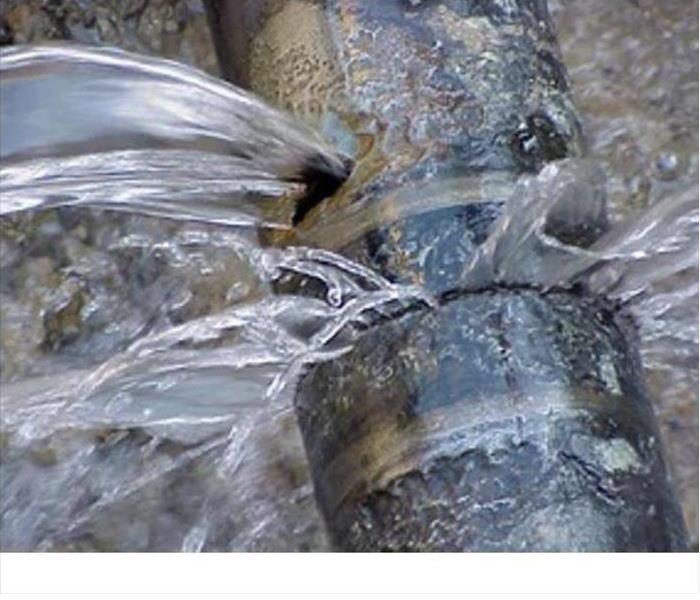 We got you! Call us. We will take care of it.
We got you! Call us. We will take care of it.
Leaks from piping, roofs and other overlooked areas can cause water damage, that can go unnoticed for an extended period of time. Attempting to clean up water from a leak can lead to further damage or contamination if not handled properly. Our technicians are highly trained professionals that specialize in water mitigation. Our SERVPRO name means everything to us, and we have been around for some time now. Having a good brand and name you can trust is important. You will always be certain that you are in the best of hands with SERVPRO.
We want you to understand the process, and our teams of technicians will walk you through every step, keep you updated on the progress of the job, and get you back to good.
Water damages can happen at anytime. It is it's always good to know that there is someone that can be there for you no matter what time a day it. SERVPRO of Arcadia is open 24-hours, 7 days a week. We got this.






 24/7 Emergency Service
24/7 Emergency Service












